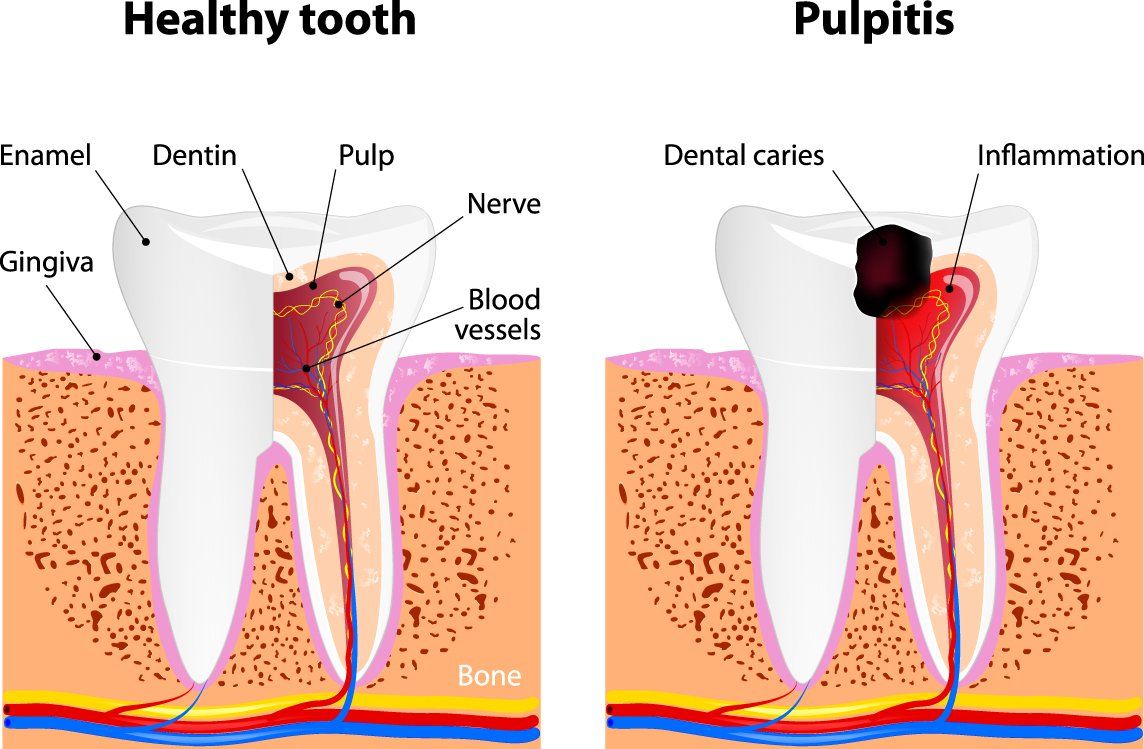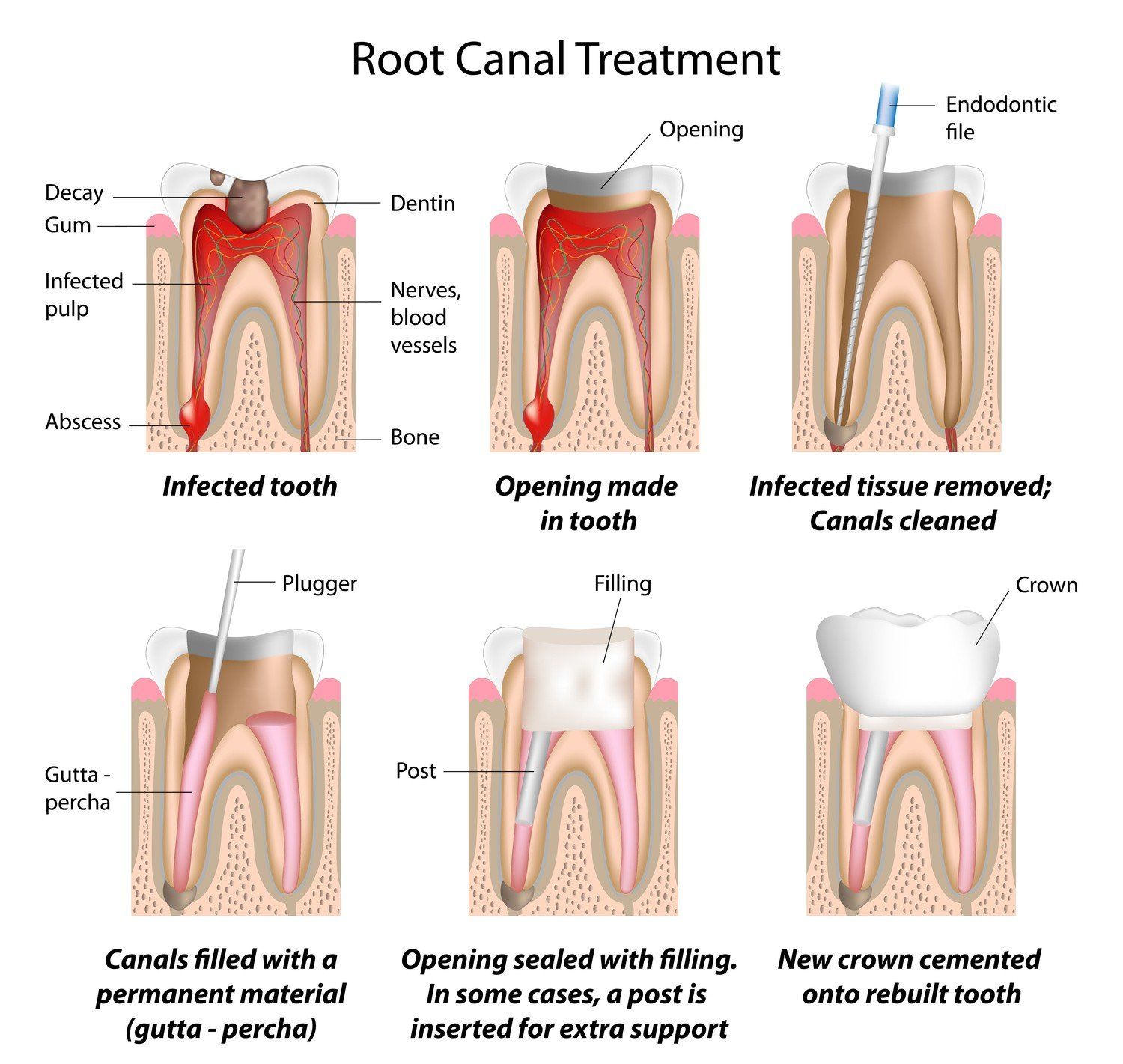ROOT CANAL TREATMENT
In the past, injured or dying teeth had to be extracted. Fortunately modern dentistry gives us the option to save such teeth by completing root canal treatment (also known as endodontic treatment). Root canal treatment is highly successful and the tooth will often last the rest of its life.
What is root canal treatment?
Watch the video above for a great illustration of the root canal process. It starts with the cleaning out of an infected tooth, follows with the filling of the root canal and finishes with the placement of a post and crown. The post and crown are just one option for restoring a tooth after root canal treatment. See below for a more detailed explanation of the stages.
Why is root canal treatment needed?
Teeth are hollow and filled by the dental pulp, often referred to as ‘the nerve’. If the pulp is exposed to bacteria through dental decay, from a cracked tooth or damage from an accident, it may develop pulpitis. Pulpitis is inflammation of the pulp and if left untreated may cause the pulp to die. Once the pulp starts to die it is an irreversible process. It is often painful and is only stopped by root canal treatment. Root canal treatment removes the pulp, carefully cleans out the inside of the tooth and then fills the empty space.
What are the signs of a dying tooth?
An inflamed and repairable pulp can often make a tooth sensitive to hot, cold, sugar. These symptoms usually last only a few seconds. The signs that a pulp is starting to die are severe pain, often with a tooth that is acutely sore to biting or tapping. The pain lasts for several minutes or more, and may come on by itself, with no stimulus. Pain that wakes you up in the night is also a bad sign. If you are experiencing these then give us a call as soon as you can.
The stages of root canal treatment in more detail
To get the best result, root canal treatment usually takes two or more visits.
1. First Visit
- We start with an examination and x-ray to diagnose which tooth is causing the problem and discuss your treatment options.
- The tooth is numbed with local anaesthetic to ensure the procedure is pain free.
- To isolate the tooth from saliva we place a rubber sheet called a dental dam around the tooth.
- Once we are sure the tooth is numb, we make a small hole through the top of the tooth to access the pulp chamber. Using miniature files we carefully remove the pulp. The inside of the tooth is measured, shaped and rinsed clean with a sterilising solution.
- If the tooth is being retreated, this is where we remove the old root filling material.
- To help kill the bugs, an antibacterial dressing is placed along with a temporary filling on the top. We leave this in place for 1-2 weeks to allow time for the dressing to work.
2. Second Visit:
- The temporary filling is removed and antibacterial dressing flushed out.
- If the infection has not resolved the tooth may need to be dressed and temporised for a second time.
- Otherwise the root canals are dried and filled with a filling material called gutta percha. A permanent core (or foundation) is placed into the top of the canals in preparation for the final restoration on the top of the tooth.
Restoring a tooth following root canal treatment
Sealing the top of the tooth is vitally important for the long term success of root canal treatment. Root filled teeth usually have a history of being heavily filled and are also at risk of fracturing. We will always recommend a restoration that preserves the most tooth and gives it the best protection for the future. Crowns or onlays made of porcelain or gold are a common way of achieving this.
Complications
Root fractures may occur before, during or after root canal treatment. Root fractures allow bacteria to get back into the sterilised tooth and cause treatment to fail. If one is seen during treatment, the tooth will not be savable and will require extraction. We look very carefully for root fractures but they are not always detectable and may rarely cause failure in future years.In some teeth the root canals are very narrow and curved. The strain placed on the metal files can occasionally cause the very tips to fracture during use. Every effort is made to remove the file but if it is stuck we will fill around it. All the files are made of medical grade nickle-titanium or stainless steel and there is no health risk to leave them inside a tooth. Fractured files are only a problem when they block access to the rest of the root canal. File fracture is an accepted risk of root canal treatment and very uncommon.
Wellington CBD Location
© 2024
Discover Dental
Contact
04 472 3510


